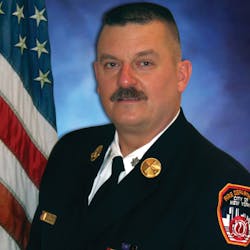So, you are a hard-working, fun-loving firefighter for more than 10 years, and you love the job. You have worked in an active unit that has great officers, and your brother and sister firefighters and you have more than a bit of experience. Suddenly, one morning, on the way home from a 24-hour shift, you think to yourself, “Maybe I should try for a promotion and sit in the front seat.” After thinking about it and talking to your family and close friends, you jump in with both feet and begin the process.
Skip ahead two years: You are promoted and working shifts in various companies while you break in. Everything seems fine for a while until you start to notice that you aren’t really being included in all of the discussions and bantering around the firehouse. You know that you are the officer, but you still feel like “one of the boys.” Well, that’s your first mistake.
One of the most difficult transitions to make in the fire service is the first promotion to officer from firefighter. And it doesn’t matter whether you are a career or volunteer firefighter. The differences and difficulties are the same. Whether the promotion is to lieutenant or captain, the first-line supervisor plays a critical role in the daily operations of a fire company.
Strap in
I love to start this conversation with the seat belt discussion. First, let me say that everyone—firefighters and officers—should wear seat belts every time that the apparatus wheels are rolling. However, if you never or rarely wore your seat belt as a firefighter, get ready to make some changes. First, you must wear your seat belt every time that you are underway. Next—and this is the “fun” part—you must ensure that all of your people wear their seat belts, too. No discussions, no pleading, no exceptions. Some apparatus have sensors that are in the seats that ring a bell and activate a light in the cab, so the officer knows that a seat belt isn’t being worn in a seat that’s occupied. I guess that might help, but, really, all that you need to do is turn around and look. If any of your people aren’t complying, just tell the driver to set the parking brake and wait for compliance.
Another situation that can be problematic is when a newly promoted officer works with members who they were a firefighter with previously. In smaller or even midsize departments, a firefighter can have a long work history with other firefighters on the shift: the work together, the talk about the job, how each knows a lot about the others. Then one of them is promoted and shows up asking the firefighters to start or stop behaving in a certain way or performing duties in a certain way. The problem arises when the firefighters inform the new officer that the new officer used to behave in exactly the same way. Sometimes, a new officer’s work history isn’t helpful to that officer’s new responsibilities. New officers must sometimes press the reset button and turn over a new leaf.
To be taken seriously
Another situation that can cause problems is when an officer joins in the verbal antics inside of the firehouse. Firefighters are well-known for not letting each other off easy and often use jokes and other “funny” displays to have a laugh. Even when firefighters do this among themselves, there are limits. (Everything is funny “until someone loses an eye.”) However, as you ascend through the ranks, your participation in practical jokes and comical comments isn’t acceptable. At some point, a firefighter might need your professional assistance or to be disciplined. These are difficult undertakings under the best of conditions but more difficult or maybe impossible when the officer took part in verbal comedy earlier in the shift and now wants to be taken seriously.
Officers of all ranks must remember that once you are promoted you join the group that firefighters call “they.” You must set an example in everything that you do. How you look, how you talk, how you dress are all important. Sure, your tactical ability is important, too, but we spend much more time in the firehouse than on the fireground. When you step up you must shape up.
About the Author
John J. Salka Jr.
Battalion Chief
JOHN J. SALKA JR., who is a Firehouse contributing editor, retired as a battalion chief with FDNY, serving as commander of the 18th battalion in the Bronx. Salka has instructed at several FDNY training programs, including the department’s Probationary Firefighters School, Captains Management Program and Battalion Chiefs Command Course. He conducts training programs at national and local conferences and has been recognized for his firefighter survival course, “Get Out Alive.” Salka co-authored the FDNY Engine Company Operations manual and wrote the book "First In, Last Out–Leadership Lessons From the New York Fire Department." He also operates Fire Command Training, which is a New York-based fire service training and consulting firm.

